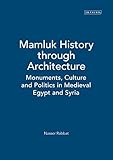Mamluk history through architecture Book : monuments, culture and politics in medieval Egypt and Syria / Nasser Rabbat.
Material type: TextSeries: Library of Middle East history ; 21Description: xiv, 261 pages : illustrations, plans ; 26 cmISBN:
TextSeries: Library of Middle East history ; 21Description: xiv, 261 pages : illustrations, plans ; 26 cmISBN: - 9781845119645 (hardback)
- 1845119649 (hardback)
- 720.9560902 22
- 720.9560902
| Item type | Current library | Call number | Status | Date due | Barcode | Item holds |
|---|---|---|---|---|---|---|
 Books
Books
|
Junaid Zaidi Library, COMSATS University Islamabad | 720.9560902 RAB-M 61369 (Browse shelf(Opens below)) | Available | 10001000061369 |
Browsing Junaid Zaidi Library, COMSATS University Islamabad shelves Close shelf browser (Hides shelf browser)

|

|

|

|

|

|

|
||
| 720.955 STI-P Persian art & architecture | 720.955 STI-P Persian art & architecture / | 720.956 MEI-P Patterns of stylistic changes in Islamic architecture local traditions versus migrating artists / | 720.9560902 RAB-M 61369 Mamluk history through architecture monuments, culture and politics in medieval Egypt and Syria / | 720.9561 BLE-A 61010 Analysis of electric machinery and drive systems | 720.9561 MCC-R Rum Seljuq architecture, 1170-1220 : the patronage of sultans / | 720.9561 OSM-T Deutsche Wirtschaftsgeschichte von 1945 bis zur Gegenwart |
Mamluk architecture is key to the social history of the period. Analysing Mamluk constructions as a form of communication and documentation as well as a cultural index, Mamluk History Through Architecture shows how the buildings mirror the complex-and historically unique-military, political, social and financial structures of Mamluk society. With this study Nasser Rabbat offers an innovative approach to the history of the Mamluks-through readings of the spectacular architecture of the period. Mamluk History Through Architecture ranges over some of the greatest architectural achievements of the Mamluk world, showing how architecture played a distinct role in the social and political life of the time. Drawing on examples from throughout both Egypt and Syria, Rabbat demonstrates how Mamluk architecture served to reinforce visually the spirit of the counter-Crusade, when the Muslim world rebounded from the setbacks of the First Crusade. In Egypt, Rabbat explores the famous Citadel of Cairo, the seat of power in Egypt for seven hundred years, shedding light on the governments that inhabited this building, while also showing how al-Azhar Mosque served as a barometer for the status of Cairo's ruling elites. And in Damascus, Rabbat speculates on the brief resurgence of glass mosaic in Mamluk art of the thirteenth century, tying this artistic flourishing to the wider social spirit of the time. --Book Jacket
All


There are no comments on this title.